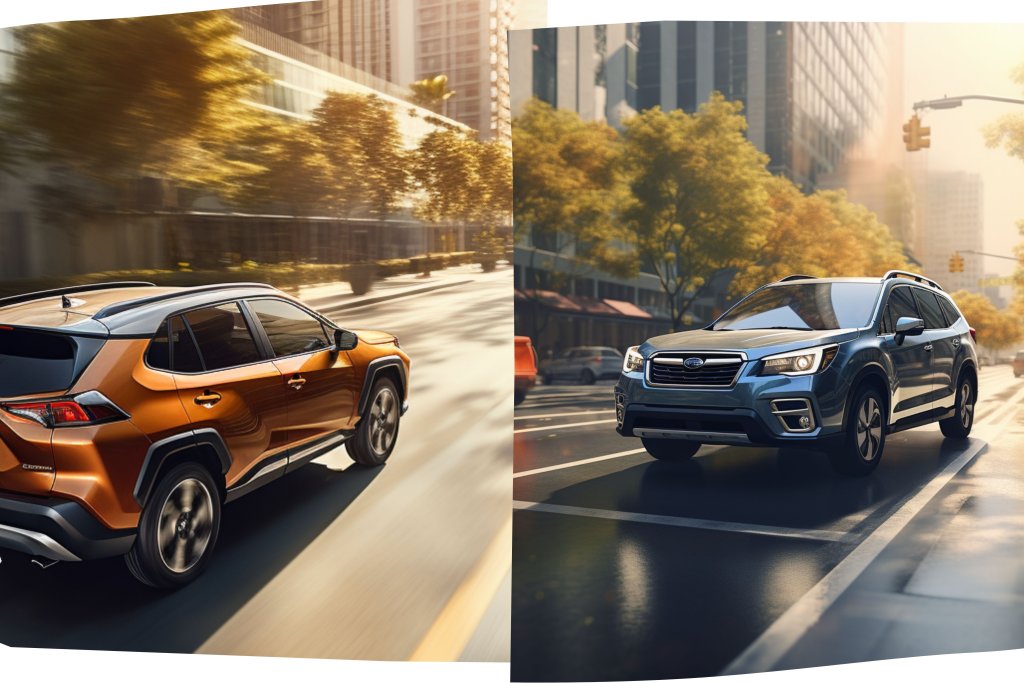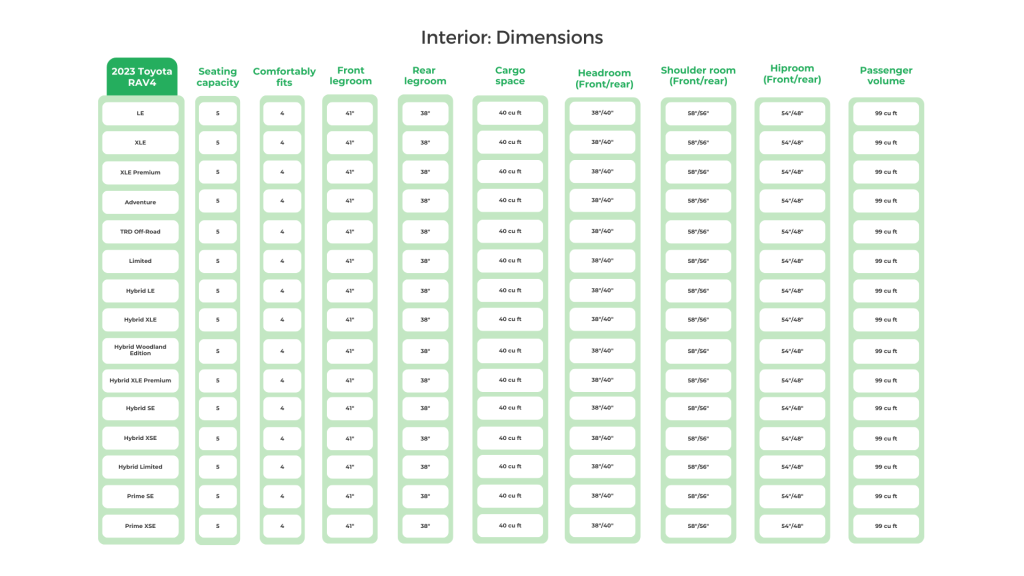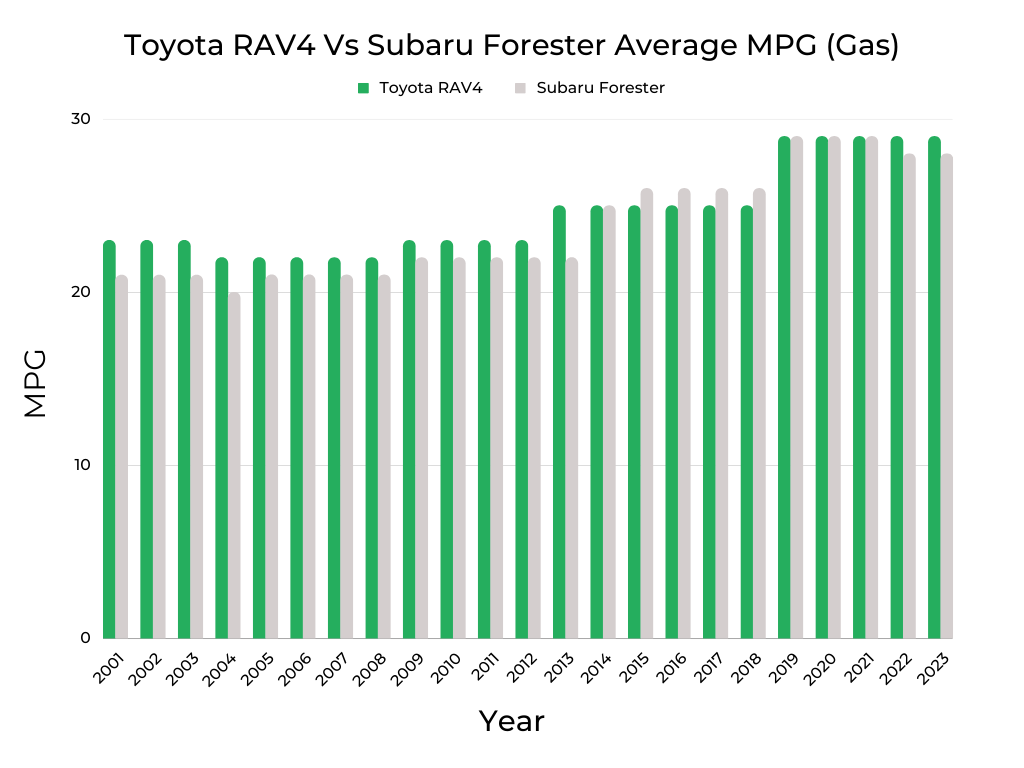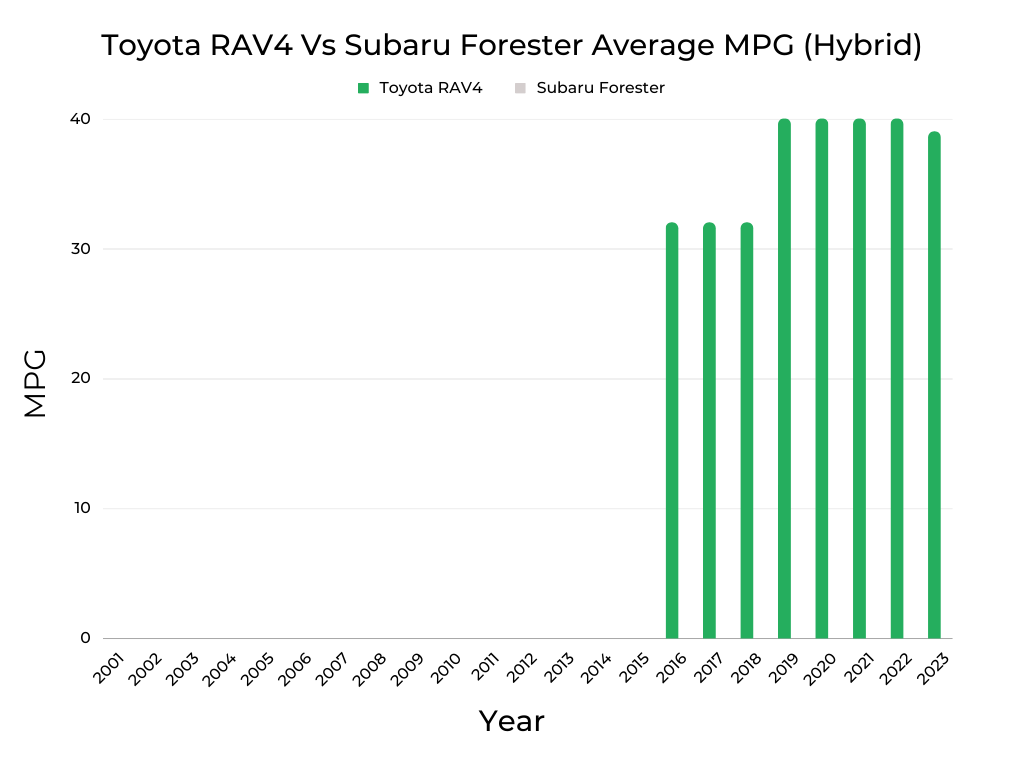Right now, there’s no hotter segment in the car business than the compact crossover. Buyers can’t get enough of those small utilities. And every mainstream automaker has an entry. The Toyota RAV4 is the category’s best-seller, but the Subaru Forester is an aggressive challenger, always seeking to do better.
Interestingly, Toyota is a minority shareholder of Subaru, but the tie-up doesn’t appear to lessen the competitive spirit. Both automakers vie for the same crossover customer. Toyota’s revered reputation for dependability very much influences the market for the RAV4. This means you’ll pay more for a RAV4 than a comparable Forester, regardless of whether you’re buying new or used.
A dive into the details does tarnish Toyota’s shining standing somewhat. RAV4s are more prone to check engine lights than Foresters. This is hard to believe, but the data from thousands of installed FIXD sensors don’t lie about engine reliability.
However, thinking that the Forest is perfect isn’t the takeaway here, either. Owning one of these Subarus means spending more on maintenance than the RAV4. The Forester also comes up short by not offering certain comfort and convenience features.
Keep reading to discover what separates the Toyota RAV4 and Subaru Forester from each other. You’ll find this information helpful if you’re considering a new car or already have one in the driveway.
| Income Bracket | Monthly Financing Cost Range | Cash Purchase Price Range | Subaru Forester Years | Toyota RAV4 Years | Best Model Year: | Why? |
| < $5k | $42-$83 | $1,500 – $3,000 | 2002 | n/a | 2004 Forester | Affordability |
| $5k-$10k | $83-$125 | $3,000-$4,500 | 2009-11 | 2002 | 2009 Forester | Good Value, Decent Engine Reliability |
| $10k -$15k | $125-$187 | $4,500-$6,750 | 2013 | 2009 | 2013 Forester | Solid Value, Strong Engine Reliability |
| $15k -$25k | $187-$312 | $6,750 – $11,250 | 2015 | 2013 | 2015 Forester | Great Value, Strong Engine Reliability |
| $25k -$35k | $312-$437 | $11,250-$15,750 | 2017 | 2015 | 2017 Forester | Newer Model, Excellent Engine Reliability |
| $35k – $50k | $437-$625 | $15,750-$22,500 | 2020 | 2018 | 2018 RAV4 | More Affordable |
| $50k – $74k | $625-$925 | $22,500-$33,300 | 2021 | 2019 | 2019 RAV4 | More Affordable |
See the methodology for the table above.
Before you respond to the “For Sale” ad, check out this How to Buy a Used Car article for a step-by-step checklist.
Price History Comparison | Toyota RAV4 vs. Subaru Forester
Average Market Value – Based on Owners’ Self-Reported Mileages | Toyota RAV4 vs. Subaru Forester
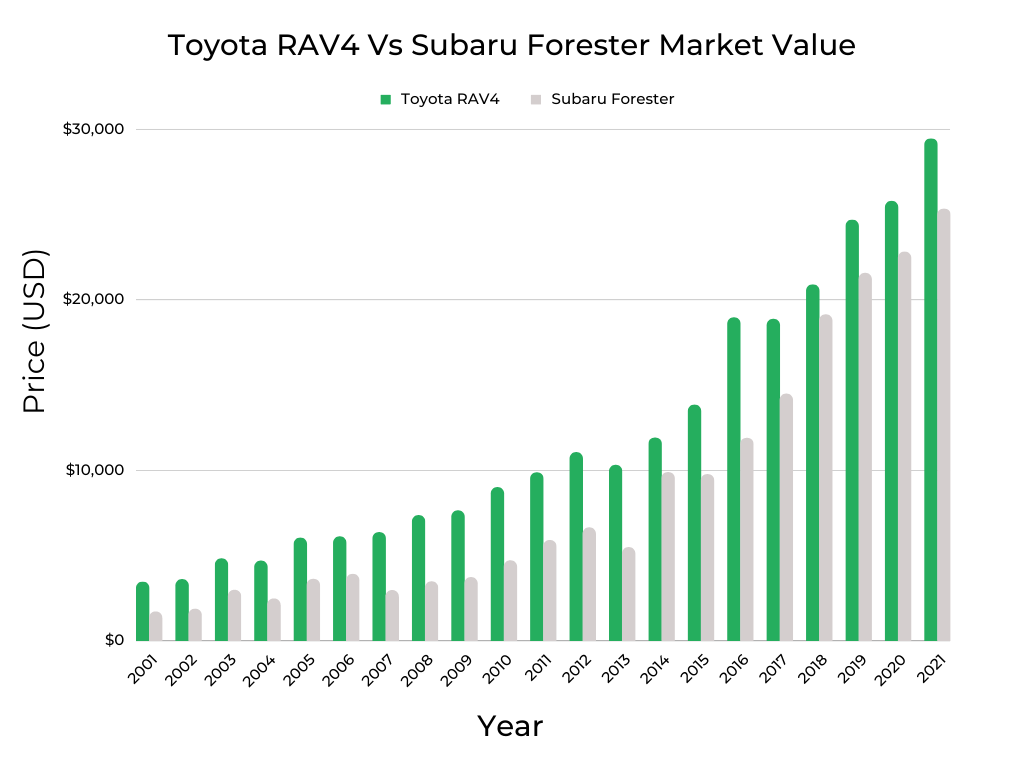
Price is a key determiner for most car purchases. Here’s a look at private-party sales for the RAV4 and Forester based on Kelley Blue Book (KBB) data. Retail purchases made through dealers typically run an additional 10%–40%, so keep this in mind as you shop. Looking for a car that’s older, is less equipped, or has higher mileage can offset the higher price at a dealership.
The chart incorporates mileage into the data; it’s a key factor. A vehicle with less mileage will be worth more than an identical cart with more miles. The model year also comes into play. The newer a car is, the greater its value. That’s exactly what we see here, with the steady increase in RAV4 (green) and Forester (gray) values as the model years become newer.
Among the most intriguing aspects of this data is that the RAV4 always sells for more than the Forester. Some of this is due to the higher mileage reported by Forester owners in the FIXD surveys. But, even for the years (2002, 2005-2007, 2014, and 2018-2020) that the RAV4 has higher owner-reported mileage, these Toyotas still cost more than their Subaru counterparts.
In practical terms, you’ll almost always pay more for a RAV4 than the equivalent Forester.
Be sure to read our Best and Worst Years series of articles highlighting the Toyota RAV4 and Subaru Forester winners and losers.
Depreciation vs. Maintenance Expenses
Depreciation is the unpleasant part of buying a new car. Hang on to it for five years, and its value will probably drop by half. Even newer used vehicles can take a hit on value. Unusual market conditions have somewhat lessened the impact of depreciation, but no one knows how long this will last.
One way to remove the worry about depreciation is to shop for an older car. Someone else has already taken the loss. However, you don’t want any older car. The secret is to find a pre-owned vehicle that balances modest repair costs with low depreciation. This is the sweet spot indicated by the outlined box in each chart.
The data shows that the 2004-2009 RAV4 model years offer the most value. At the same time, Forester shoppers will find more choices because greater value rests with the 2002-2011 model years. However, maintenance costs (green) are higher for the Forester—we’ll explore this in more detail later. In other words, you may have a better selection of these Subarus, and they may cost less than a similar RAV4, but you’ll spend more to keep it on the road.
Learn more by reviewing the best and worst years of the Toyota RAV4 and Subaru Forester.
Reliability Comparison | Toyota RAV4 vs. Subaru Forester
Two ratings are at the core of our look at the Toyota RAV4 and Subaru Forester.
- The FIXD Reliability Score measures the number of check engine lights recorded for a particular model year by installed FIXD sensors. Think of it as an engine reliability score. While every check engine light doesn’t directly translate into reliability concerns (such as a dead battery or loose gas cap), these indicators still provide insight into a car’s dependability.
- The second rating is the Owner Reliability Score. This is a subjective ranking of how surveyed owners feel about their respective vehicle’s dependability. Each owner estimates how capable their car is for trips of different lengths. A vehicle that can handle a cross-country adventure receives the highest score, while a car only suitable for a quick point A to point B trip gets the lowest score.
Both rankings are based on 1 being the lowest, 10 being the highest, and 5 being the average score.
We’ll also point out that both scores seldom align. The FIXD Reliability Score is determined by a definitive number, the frequency of check engine lights. On the other hand, the Owner Reliability Score is opinion-based. And owners tend to have pride in their automobiles, with higher ratings as a result. At a minimum, those with older vehicles are more accepting of check engine lights. For many, it’s the price of owning an aging car.
It would be reasonable to assume that the Toyota RAV4 is more dependable because it has a more reliable engine. However, that way of thinking is proven wrong by the FIXD Reliability Scores for the RAV4 and Forester. For most years (13 out of 21), the Forester has fewer check engine lights than the RAV4. The Toyota came out on top for only three years, and both cars tied with identical scores for five years.
We must point out that not every check engine light translates to a breakdown or expensive repair bill. Sometimes, a loose gas cap or failing car battery can trigger an error message. Yet, the differences in engine reliability between the RAV4 and Forester are striking.
Often, favorable owner perceptions can impact market value. We see this with other Toyotas, such as the Corolla. Yet, owner beliefs about dependability are evenly split. As shown in the second chart, Forester owners ranked their cars higher for eight years, compared to seven years for those with a RAV4. There was a tie for six years.
Review the Best and Worst Years articles on the Toyota RAV4 and Subaru Forester to learn more about these vehicles’ FIXD Reliability and Owner Reliability Scores.
Longevity Comparison | Toyota RAV4 vs. Subaru Forester
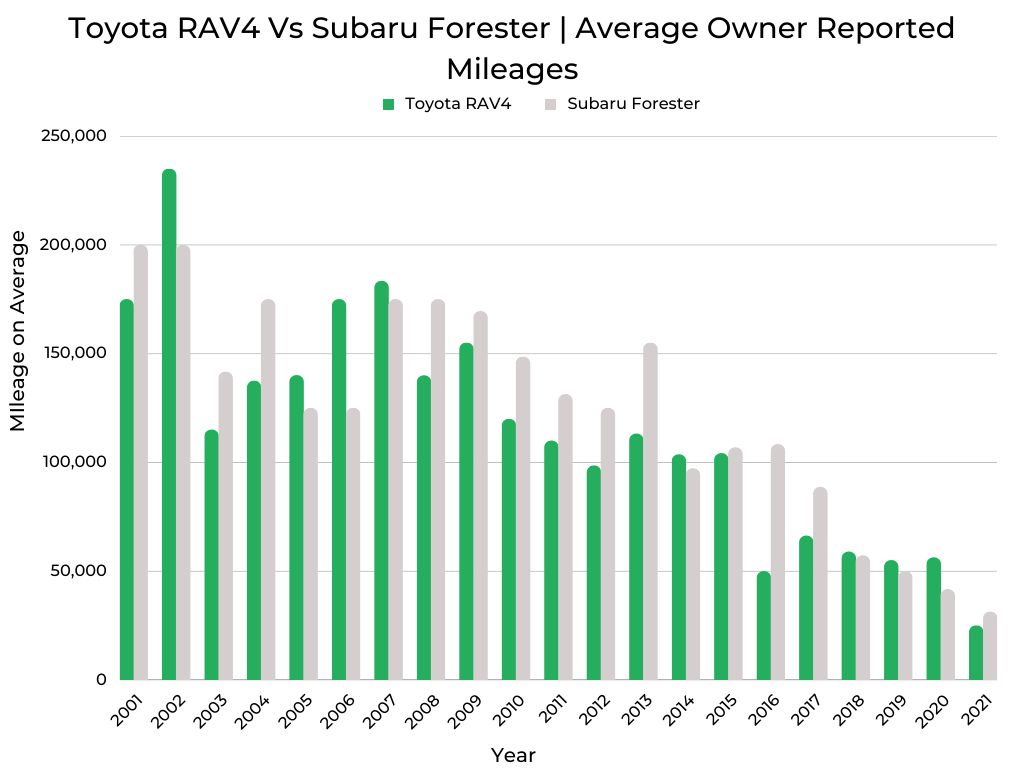
The RAV4 and Forester can achieve high-mileage status regardless of engine and owner reliability scores. We see that many examples have crossed the 150,000-mile benchmark, with some reaching or going beyond 200,000 miles. This is impressive.
Importantly, the results are based on FIXD owner surveys, not estimates or conjecture. Vehicle quality contributes significantly to longevity, but the formula also includes excellent maintenance and an ability to avoid accidents.
Review the individual articles on the best and worst years of the Toyota RAV4 and Subaru Forester for a more thorough look at longevity.
2023 Toyota RAV4 vs. Subaru Forester | A Guide to Trim Levels & Optional Features
Trim Levels: Starting Prices
The RAV4 and Forester are extremely popular; they are among the best-selling non-truck vehicles in the U.S. To maintain this success, automakers offer many trims, so there’s something for the low-budget buyer and the shopper who wants all the bells and whistles.
Excluding the RAV4’s hybrid and plug-in hybrid (Prime) offerings, both Toyota and Subaru sell the same number of variations: six. However, the similarities mainly stop there.
Most notably, the base Forester, at $26,495, is substantially cheaper than the starter RAV4 LE ($28,275). The gap widens because all-wheel drive (AWD) is standard with all Foresters. You’ll need another $1,400 to get all the RAV4 LE’s four wheels spinning.
The price gulf continues as we move up the trim range. Manufacturers have caught on that some crossover buyers want enhanced off-road capabilities (even if these features aren’t equivalent to what’s in more robust SUVs). Hence, the birth of the Forester Wilderness and RAV4 TRD Off-Road. Both cars have a more rugged suspension, extra-capable tires, and increased ground clearance (the TRD Off-Road also gets AWD).
Yet, similar characteristics don’t translate into similar prices. The Wilderness goes for $34,320, compared to $37,895 for the TRD Off-Road—a 10% premium.
Buyers who want rugged looks but don’t need the off-road goodies face a similar dilemma. The Forester Sport has a $31,265 sticker, while the AWD-equipped RAV4 Adventure sells for $34,470—also a 10% difference.
At the top end, the RAV4 Limited ($36,580) gains the upper hand with a lower cost than the Forester Touring ($36,795). However, the price advantage vanishes once AWD (a $1,400 upgrade) gets added to the Toyota.
For shoppers looking solely at the bottom line, the 2023 Subaru Forester is the apparent winner, especially at the base and mid-tier levels. However, the picture becomes less clear if AWD is not a must-have feature.
| 2023 Subaru Forester | Starting Price |
| Base | $26,495 |
| Premium | $29,695 |
| Sport | $31,265 |
| Wilderness | $34,320 |
| Limited | $33,375 |
| Touring | $36,795 |
| 2023 Toyota Rav4 | Starting Price |
| LE | $28,275 |
| XLE | $29,785 |
| XLE Premium | $32,675 |
| Adventure | $34,470 |
| TRD Off-Road | $37,895 |
| Limited | $36,580 |
| Hybrid LE | $31,225 |
| Hybrid XLE | $32,735 |
| Hybrid Woodland Edition | $34,025 |
| Hybrid XLE Premium | $35,625 |
| Hybrid SE | $33,920 |
| Hybrid XSE | $36,885 |
| Hybrid Limited | $39,530 |
| Prime SE | $43,090 |
| Prime XSE | $46,960 |
2023 | Toyota RAV4 vs. Subaru Forester | Specifications | Safety, Interior and Exterior Features
Sizing up the Toyota RAV4 and Subaru Forester involves a look at each vehicle’s specifications. Here’s what you need to know.
Vehicle Class & Body Style:
The U.S. Environmental Protection Agency (EPA) classifies the RAV4 and Forester as small SUVs based on interior passenger volume and cargo area space. And although both vehicles fall into the same category, there are differences inside the cabin. Passenger volume for the RAV4 is 99 cubic feet compared to 108-112 cubic feet for the Forester.
We’ll examine interior and exterior dimensions later.
| 2023 Subaru Forester | 2023 Toyota RAV4 | |
| Class | Crossover SUV | Crossover SUV |
| 4-Door SUV | Base, Premium, Sport, Wilderness, Limited, Touring | Hybrid LE, Hybrid XLE, Hybrid Woodland Edition, Hybrid XLE Premium, Hybrid SE, Hybrid XSE, Hybrid Limited LE, XLE, XLE Premium, Adventure, TRD Off-Road, Limited, LE, XLE, XLE Premium, Adventure, TRD Off-Road, Limited |
Powertrain:
Engine Options & Specifications:
The RAV4 and Forester use similar-sized engines for standard power. Both come with a non-turbo 2.5-liter four-cylinder engine. But while Toyota uses conventional inline (four cylinders in one row) engine architecture, Subaru employs a boxer (or flat) design. Without getting too technical, a boxer has opposing cylinders on the side of a central rotating crankshaft. It helps lower a vehicle’s center of gravity. However, boxer engines can be more difficult (meaning expensive) to work on.
While each engine has the same displacement (2.5 liters), output and performance differ. The RAV4 has 203 horsepower with a 0-60 MPH time of 8.3 seconds. Meanwhile, the Forester has 182 horsepower and slightly quicker acceleration (0-60 in 8.1 seconds). Curiously, the Forester (base) weighs about 85 pounds more and has somewhat less engine torque than the entry-level RAV4.
Where the RAV4 and Forester match up (almost) is fuel economy. An AWD RAV4 LE is EPA-rated for 27 MPG in the city and 34 MPG on the highway, while the starter Forester almost ties with 26 city/33 highway.
If fuel economy is a top priority, a RAV4 Hybrid comes out on top with a fuel economy rating of 41 MPG in the city and 38 MPG on the highway. This vehicle uses the same 2.5-liter engine, but it’s paired with a hybrid electric system. The plug-in hybrid RAV4 Prime falls slightly behind with an estimated 40 city/38 highway. However, it also offers an all-electric range of 42 miles.
RAV4 and Forester fuel economy are examined more thoroughly below.
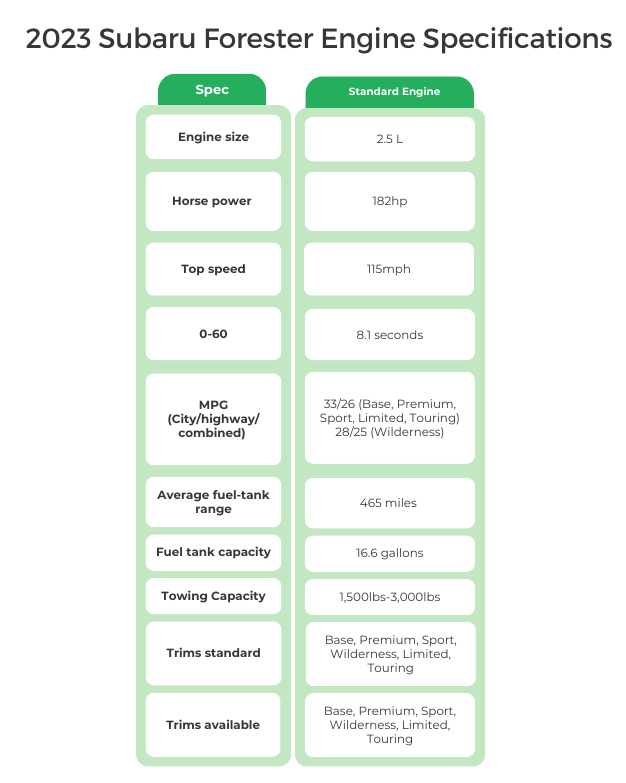
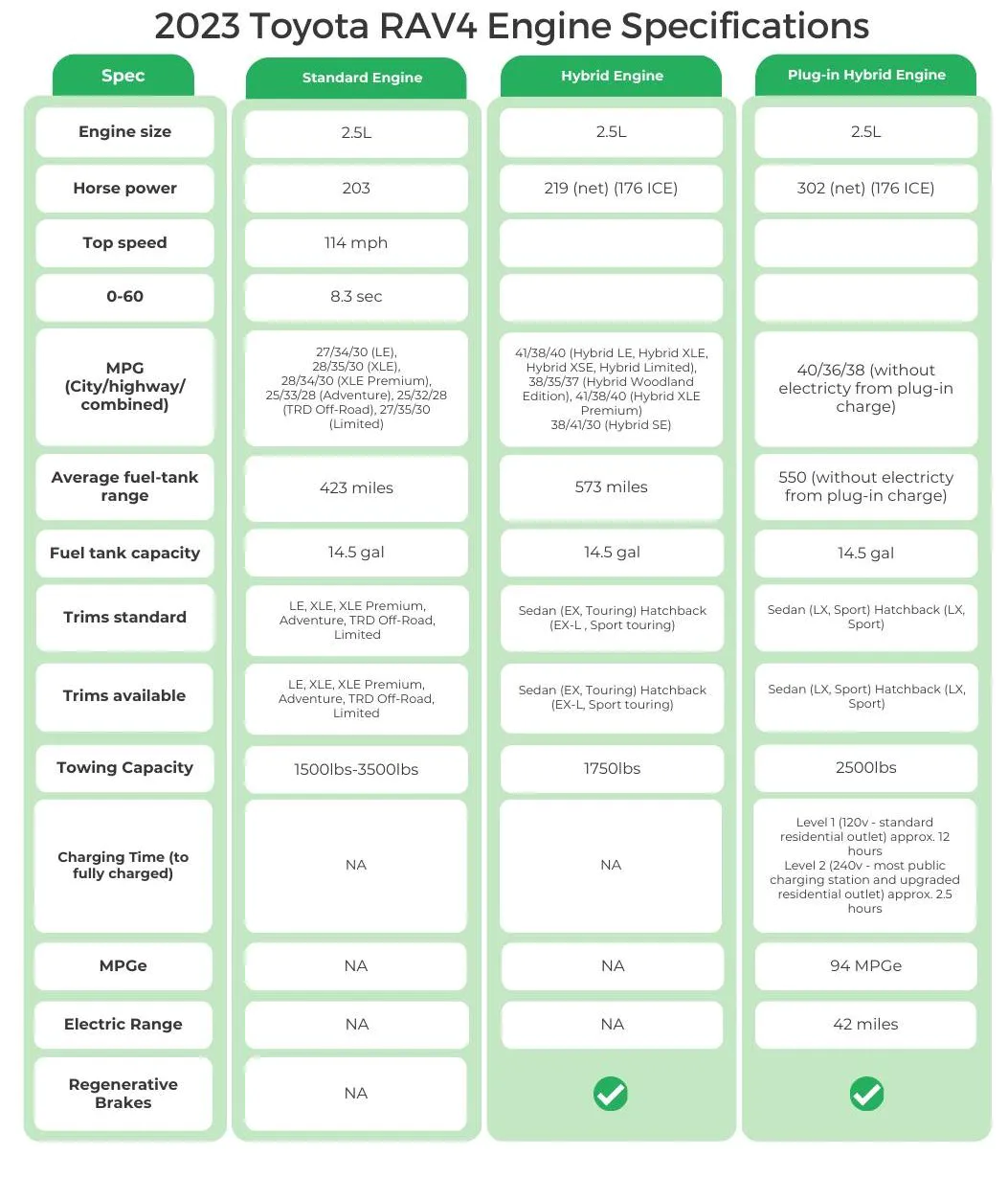
Transmission Options & Specifications:
The typical car shopper doesn’t give much thought to transmissions. Yet, this vital component helps provide a delicate balance between decent acceleration and reasonable fuel economy.
Subaru relies on a continuously variable transmission (CVT) to get the job done in the Forester. At the same time, Toyota uses a traditional eight-speed automatic with the standard engine and an eCVT with the hybrid and plug-in hybrid versions. Generally, CVTs (and eCVTS) are engineered for maximum fuel efficiency. See the “Tech Talk” section below the charts to learn about CVTs and eCVTs.
If you want a manual gearbox in your RAV4 or Forester, you’re out of luck. Neither manufacturer has offered a stick for years.


TECH TALK: CVTs
A continuously variable transmission (CVT) does not use gears like a typical automatic transmission. Instead, it has two pulleys connected by a belt. One pulley connects to the engine, and the other connects to the wheels. The belt transfers the power between the pulleys. This setup allows the pulleys to continuously change positions as needed. The CVT automatically adjusts the pulleys as required, providing smooth and efficient power delivery.
An electronic continuously variable transmission (eCVT) uses electronic controls and electric motors to vary gear ratios instead of a belt and pulley system. Unlike a regular CVT, an eCVT has no physical pulleys or belts—the gear ratio is adjusted seamlessly by controlling the speeds of electric motors and generators. This electronic control allows faster, smoother gear ratio changes compared to a traditional CVT. An eCVT also provides more flexibility, needing less space and having fewer moving parts.
Drivetrain:
As mentioned, the Forester comes only with all-wheel drive (AWD), a helpful feature for driving in the rain or on winter roads. Toyota gives its customers more flexibility with a choice of drivetrains for most conventionally powered RAV4 trims.
However, AWD is included with all hybrid/plug-in hybrid RAV4s. Toyota engineers cleverly figured out how to add this feature without much expense. Toyota includes hybrid technology and AWD for $3,000 more than a standard RAV4, a relative bargain if both components are appealing.
| 2023 Subaru Forester Wheel Drive | FWD | AWD | RWD |
| Base | S | ||
| Premium | S | ||
| Sport | S | ||
| Wilderness | S | ||
| Limited | S | ||
| Touring | S |
| 2023 Toyota RAV4 Wheel Drive | FWD | AWD | RWD |
| LE | S | U | |
| XLE | S | U | |
| XLE Premium | S | U | |
| Adventure | D | ||
| TRD Off-Road | D | ||
| Limited | S | U(D) | |
| Hybrid LE | E | ||
| Hybrid XLE | E | ||
| Hybrid Woodland Edition | E | ||
| Hybrid XLE Premium | E | ||
| Hybrid SE | E | ||
| Hybrid XSE | E | ||
| Hybrid Limited | E | ||
| Prime SE | E | ||
| Prime XSE | E |
U = Available in upgrade
E = electric on-demand AWD
D = AWD with rear driveline disconnect
Safety:
NHTSA Safety Ratings
According to FIXD surveys, RAV4 and Forester owners use their cars for many activities. At the top is duty as a family hauler. More than half (52%) of those with a RAV4 rely on their Toyota to transport loved ones; it’s 44% for Forester owners. These compact crossovers also get called upon for “lots of driving,” meaning commuting and long travels.
All this time behind the wheel requires a keen look at safety. Fortunately, the 2023 RAV4 and 2023 Forester deliver. National Highway Traffic Safety Administration (NHTSA) crash data shows that both cars received a perfect 5 out of 5 rating for overall safety performance.
The RAV4 does fall slightly behind (4 out of 5) in the frontal crash test (the Forester received a 5), but this is still respectable. Any score of 4 or better is laudable.
The RAV4 and Forester each receive a 4 in NHTSA’s rollover evaluation. This is common for crossovers, SUVs, and trucks with a higher body height.
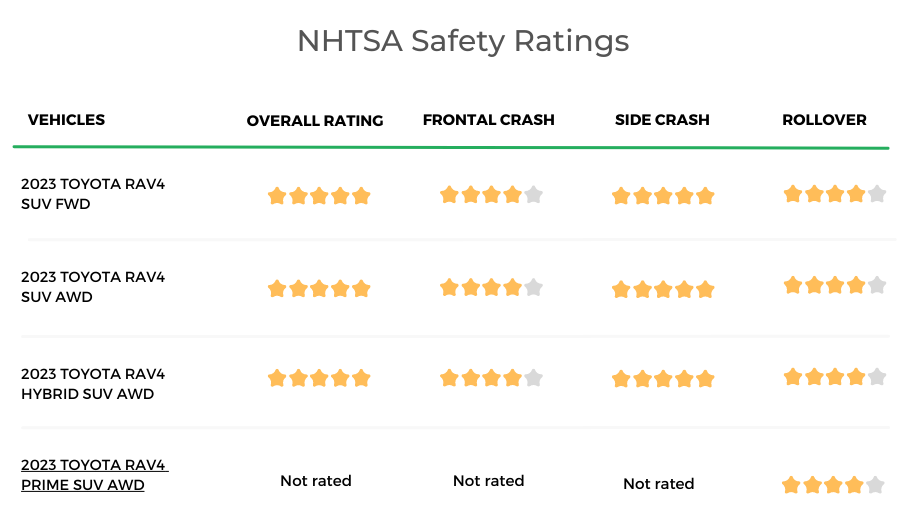
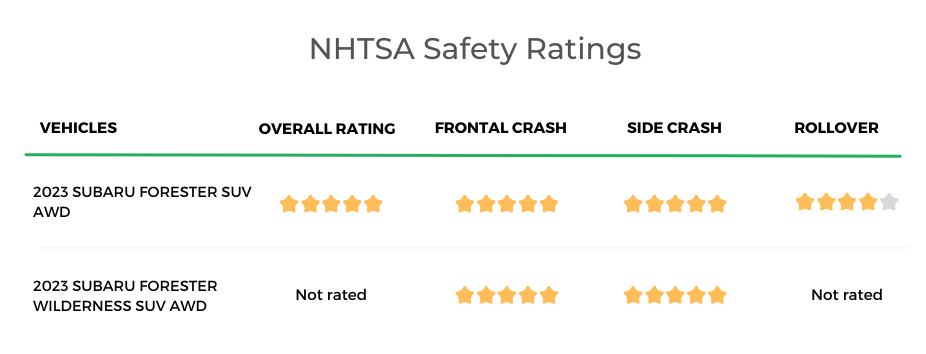
IIHS Awards:
The Insurance Institute for Highway Safety (IIHS) takes a somewhat different approach to safety testing. In particular, it focuses on its small frontal overlap crash test, which the organization feels represents a more real-world scenario (a single car running into a fixed object). IIHS also looks at side impact crashes, roof strength, headlight effectiveness, and advanced driver safety technologies (like automatic emergency braking).
While tested vehicles receive a Good, Acceptable, Marginal, or Poor grade, the true measure comes if a car gets a Top Safety Pick or Top Safety Pick+ designation. If “Good” is a “B” grade, Top Safety Pick notches things up to an “A-,” and the Top Safety Pick+ signifies an “A+”
The 2023 RAV4 and 2023 Forester are rated Top Safety Picks by IIHS.
| IIHS Award | Tested Vehicle | ||
| 2023 Subaru Forester | SMALL SUV/4-DOOR SUV | TOP SAFETY PICK | 2019 Subaru Forester 2.5i Premium 4-Door 4wd |
| 2023 Toyota RAV4 | SMALL SUV/4-DOOR SUV | TOP SAFETY PICK | 2019 Toyota RAV4 XLE 4-door 4wd |
Airbags & Head Restraints:
Airbags are often an afterthought for car buyers, yet these essential safety devices save 3,000 lives each year, reports NHTSA.
Buyers can rest assured that the RAV4 and Forester have multiple airbags to protect the driver and passengers. In addition to front units, both cars have seat-mounted airbags to protect the front row. Side curtain airbags shield both rows of occupants during a side-image collision or rollover. Overhead airbags are a new ceiling-mounted technology that replaces the traditional dashboard-based units for the front row. These are in very vehicles at the moment. Drivers of the RAV4 and Forester are further safeguarded by a knee airbag that properly positions the body during an accident to minimize injuries.
Active head restraints are usually found in specialty and high-end vehicles to minimize whiplash injuries. Mainstream cars like the RAV4 and Forester don’t usually come equipped with this feature.
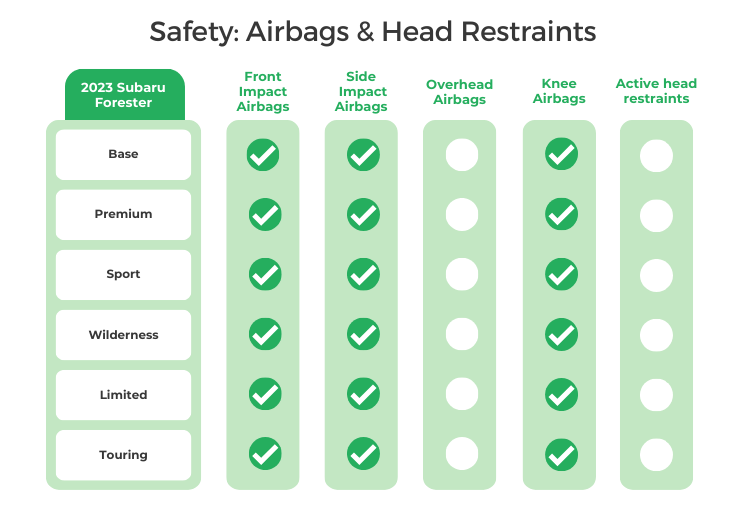
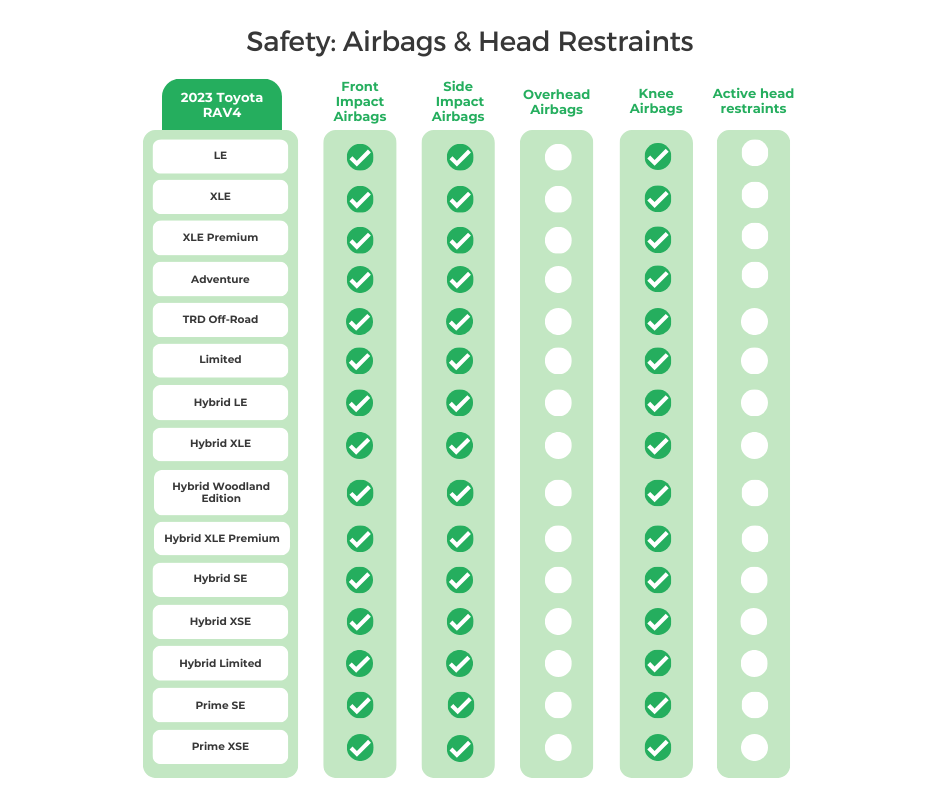
Semi-Autonomous Driving:
Don’t expect ordinary vehicles like the RAV4 and Forester to have hands-free driving technology any time soon. People aren’t buying crossovers for cutting-edge features (although Nissan does offer semi-autonomous driving in the Nissan Rogue).
However, all 2023 RAV4s and Foresters come with adaptive cruise control (ACC)—Toyota calls this technology Dynamic Radar Cruise Control. ACC reduces driving stress. It automatically slows your car when traffic is detected ahead. Once traffic clears, it speeds the car back up. Adaptive cruise control lessens the need for constant braking and acceleration. But it is not fully autonomous. Drivers must still pay attention and hold the steering wheel.
The Toyota RAV4 and Subaru Forester have comparable lane-keeping assist to help drivers stay centered, though each company uses a different name for the technology. Both systems use sensors to monitor road lines and make minor steering corrections to keep the vehicle in its lane, working with adaptive cruise control.

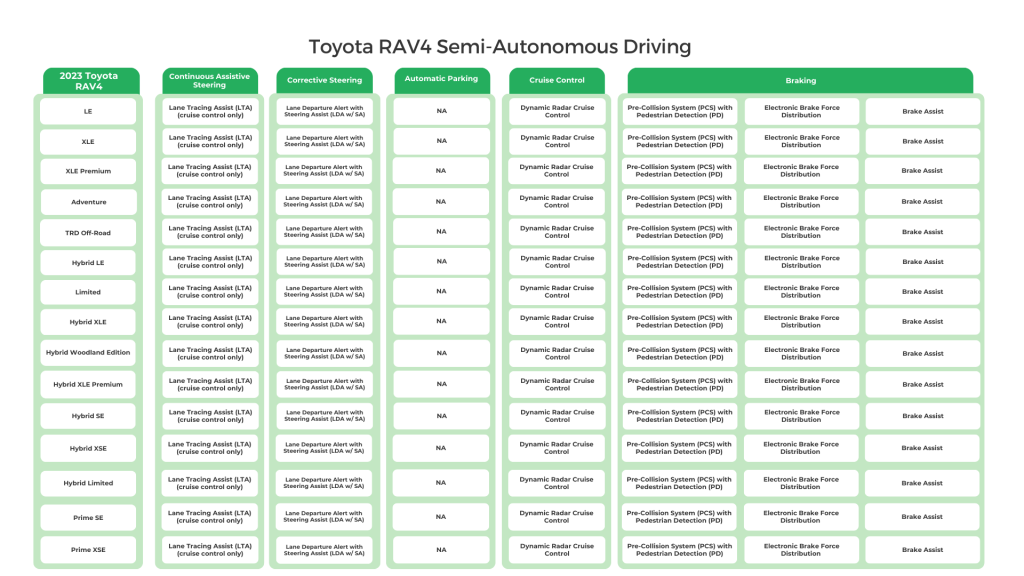
Driver Warning Systems & Telematics:
The Toyota RAV4 and Subaru Forester are equipped with an array of similar advanced driver assistance systems (ADAS) to minimize or prevent accidents.
Among these features is forward collision warning (FCW), which scans the road ahead for possible obstructions and alerts the driver. Lane departure warning (LDW) is another standard safety feature that signals if the car drifts outside its lane. Although not highlighted below, ADAS gear for the RAV4 and Forester includes automatic emergency braking (AEB). AEB automatically brakes the car if an imminent collision is detected.
Blind-spot monitoring (BSM) and rear cross-traffic alert (RCTA) are standard with most RAV4 trims (it’s an upgrade with the base LE). The same goes for the Forester. However, BSM and RCTA aren’t available on the base versions, and adding this technology to the Forester Premium costs extra.
Traffic sign recognition (a display with speed limit and other sign information) comes with all RAV4s but isn’t available with the Forester. In contrast, the top-tier Forester Touring gets a driver attention monitor, something that’s excluded from the RAV4.
If ADAS technology appears like alphabet soup, check out an effort from AAA, Consumer Reports, J.D. Power, and other groups working to standardize the terminology for these systems.
| 2023 Subaru Forester | Driver Warning Systems | Telematics | |||||||||
| Intersection Turn Assistance (ITA) | Lane Departure Warning (LDW) | Traffic Sign Recognition (TSR) | Forward Collision Warning (FCW) | Pedestrian Detection | Rear Cross-Traffic Alert (RCTA) | Blind-Spot Monitoring (BSM) | Driver Attention Monitor | Safe Exit | Rear Occupant Alert | ||
| Base | NA | Lane Keep Assist | NA | EyeSight Driver Assist | EyeSight Driver Assist | NA | NA | NA | NA | NA | NA |
| Premium | NA | Lane Keep Assist | NA | EyeSight Driver Assist | EyeSight Driver Assist | Rear Cross-Traffic Alert (Available as upgrade) | Blind Spot Detection (available as upgrade) | NA | NA | NA | NA |
| Sport | NA | Lane Keep Assist | NA | EyeSight Driver Assist | EyeSight Driver Assist | Rear Cross-Traffic Alert | Blind Spot Detection | NA | NA | NA | NA |
| Wilderness | NA | Lane Keep Assist | NA | EyeSight Driver Assist | EyeSight Driver Assist | Rear Cross-Traffic Alert | Blind Spot Detection | NA | NA | NA | NA |
| Limited | NA | Lane Keep Assist | NA | EyeSight Driver Assist | EyeSight Driver Assist | Rear Cross-Traffic Alert | Blind Spot Detection | NA | NA | NA | NA |
| Touring | NA | Lane Keep Assist | NA | EyeSight Driver Assist | EyeSight Driver Assist | Rear Cross-Traffic Alert | Blind Spot Detection | DriverFocus Distraction Mitigation System | NA | NA | NA |
| 2023 Toyota RAV4 | Driver Warning Systems | Telematics | |||||||||
| Intersection Turn Assistance (ITA) | Lane Departure Warning (LDW) | Traffic Sign Recognition (TSR) | Forward Collision Warning (FCW) | Pedestrian Detection | Rear Cross-Traffic Alert (RCTA) | Blind-Spot Monitoring (BSM) | Driver Attention Monitor | Safe Exit | Rear Occupant Alert | ||
| LE | NA | Lane Departure Alert (LDA) | Road Sign Assist (RSA) | Pre-Collision System (PCS) | Pedestrian Detection | Rear Cross-Traffic Alert (RCTA). Not Standard, available as an upgrade | Blind-Spot Monitoring (BSM). Not standard, available as an upgrade | NA | NA | NA | NA |
| XLE | NA | Lane Departure Alert (LDA) | Road Sign Assist (RSA) | Pre-Collision System (PCS) | Pedestrian Detection | Rear Cross-Traffic Alert (RCTA) | Blind-Spot Monitoring (BSM) | NA | NA | NA | NA |
| XLE Premium | NA | Lane Departure Alert (LDA) | Road Sign Assist (RSA) | Pre-Collision System (PCS) | Pedestrian Detection | Rear Cross-Traffic Alert (RCTA) | Blind-Spot Monitoring (BSM) | NA | NA | NA | NA |
| Adventure | NA | Lane Departure Alert (LDA) | Road Sign Assist (RSA) | Pre-Collision System (PCS) | Pedestrian Detection | Rear Cross-Traffic Alert (RCTA) | Blind-Spot Monitoring (BSM) | NA | NA | NA | NA |
| TRD Off-Road | NA | Lane Departure Alert (LDA) | Road Sign Assist (RSA) | Pre-Collision System (PCS) | Pedestrian Detection | Rear Cross-Traffic Alert (RCTA) | Blind-Spot Monitoring (BSM) | NA | NA | NA | NA |
| Limited | NA | Lane Departure Alert (LDA) | Road Sign Assist (RSA) | Pre-Collision System (PCS) | Pedestrian Detection | Rear Cross-Traffic Alert (RCTA) | Blind-Spot Monitoring (BSM) | NA | NA | NA | NA |
| Hybrid LE | NA | Lane Departure Alert (LDA) | Road Sign Assist (RSA) | Pre-Collision System (PCS) | Pedestrian Detection | Rear Cross-Traffic Alert (RCTA) | Blind-Spot Monitoring (BSM) | NA | NA | NA | NA |
| Hybrid XLE | NA | Lane Departure Alert (LDA) | Road Sign Assist (RSA) | Pre-Collision System (PCS) | Pedestrian Detection | Rear Cross-Traffic Alert (RCTA) | Blind-Spot Monitoring (BSM) | NA | NA | NA | NA |
| Hybrid Woodland Edition | NA | Lane Departure Alert (LDA) | Road Sign Assist (RSA) | Pre-Collision System (PCS) | Pedestrian Detection | Rear Cross-Traffic Alert (RCTA) | Blind-Spot Monitoring (BSM) | NA | NA | NA | NA |
| Hybrid XLE Premium | NA | Lane Departure Alert (LDA) | Road Sign Assist (RSA) | Pre-Collision System (PCS) | Pedestrian Detection | Rear Cross-Traffic Alert (RCTA) | Blind-Spot Monitoring (BSM) | NA | NA | NA | NA |
| Hybrid SE | NA | Lane Departure Alert (LDA) | Road Sign Assist (RSA) | Pre-Collision System (PCS) | Pedestrian Detection | Rear Cross-Traffic Alert (RCTA) | Blind-Spot Monitoring (BSM) | NA | NA | NA | NA |
| Hybrid XSE | NA | Lane Departure Alert (LDA) | Road Sign Assist (RSA) | Pre-Collision System (PCS) | Pedestrian Detection | Rear Cross-Traffic Alert (RCTA) | Blind-Spot Monitoring (BSM) | NA | NA | NA | NA |
| Hybrid Limited | NA | Lane Departure Alert (LDA) | Road Sign Assist (RSA) | Pre-Collision System (PCS) | Pedestrian Detection | Rear Cross-Traffic Alert (RCTA) | Blind-Spot Monitoring (BSM) | NA | NA | NA | NA |
| Prime SE | NA | Lane Departure Alert (LDA) | Road Sign Assist (RSA) | Pre-Collision System (PCS) | Pedestrian Detection | Rear Cross-Traffic Alert (RCTA) | Blind-Spot Monitoring (BSM) | NA | NA | NA | NA |
| Prime XSE | NA | Lane Departure Alert (LDA) | Road Sign Assist (RSA) | Pre-Collision System (PCS) | Pedestrian Detection | Rear Cross-Traffic Alert (RCTA) | Blind-Spot Monitoring (BSM) | NA | NA | NA | NA |
Road Visibility Features:
Visibility features like LED headlights and automatic headlights are standard fare for most modern automobiles, as is a back-up camera (it’s required by law). So, the RAV4 and Forester are evenly matched in this respect.
Otherwise, some equipment differences separate the two cars. All Forester trims come with adaptive headlights, which direct the light beams in sync with the steering wheel. This feature, usually found in luxury cars, makes for safer turning at night and isn’t available with the RAV4. Meanwhile, the premier RAV4 Prime XSE can only be upgraded with a head-up display (which shows the speed limit and other essential information on the windshield). In addition, most RAV4 trims have rain-sensing windshield wipers as an option.
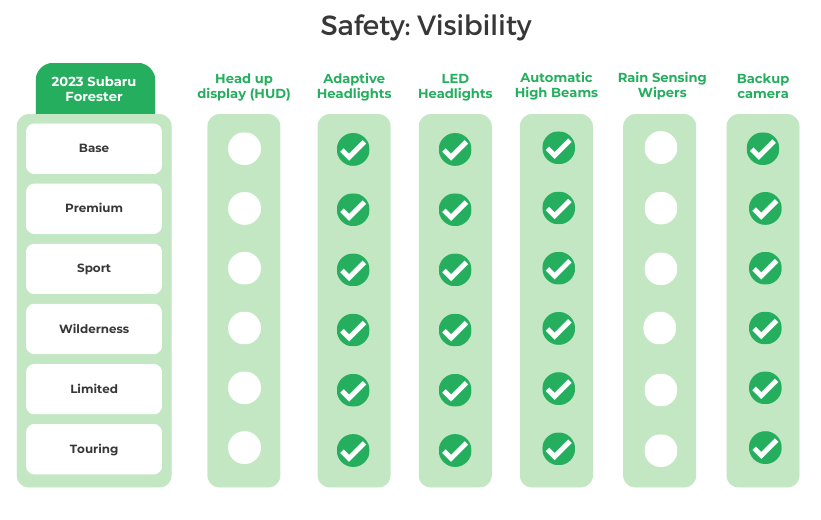
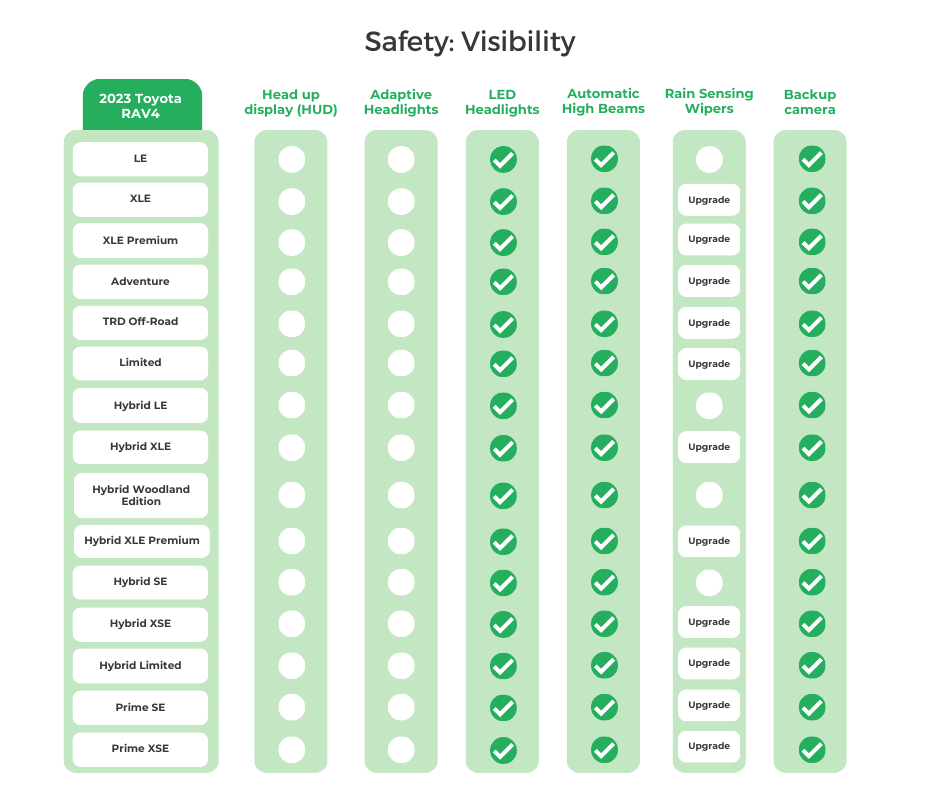
Interior:
Interior Features:
All 2023 RAV4s and Foresters come with Apple CarPlay and Android Auto—such connectivity is expected these days as most people are smartphone-dependent. Toyota and Subaru take different approaches with heated front seats. This comfort feature is optional on lower-end RAV4 trims (not available on the base LE) and standard on more premium versions. Subaru includes heated front seats on all Forester trims except the base version.
And speaking of heated seats, some automakers offer this feature through a subscription service. This hasn’t yet happened in the U.S., but in certain countries, BMW is offering heated seats for a monthly fee. The advantage is you can shut off the service during warm months, but you’ll need to keep paying (or pay a one-time upfront fee) to activate the heated seats.
One industry study shows mixed results for consumer acceptance of features on demand (FoD), with about one-fifth not even being aware of the concept.
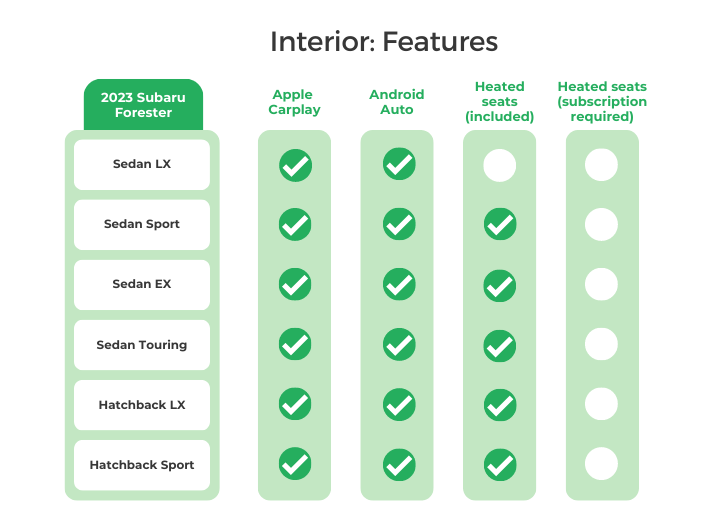
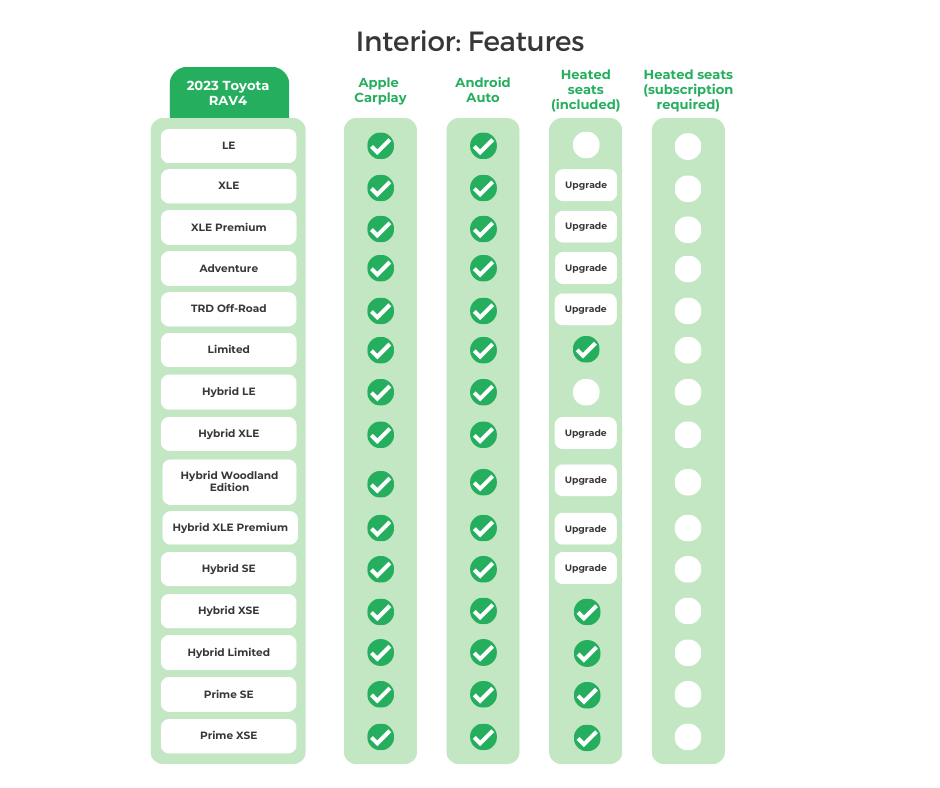
Interior Dimensions:
As highlighted earlier, the 2023 Forester has a larger cabin than the 2023 RAV4. This contrast is particularly noticeable in several interior measurements. The Forester’s 43 inches of front legroom far exceeds the 41 inches in the front row of the RAV4. This Subaru also leads in the back seat legroom, 40 inches versus 38 inches for the RAV4.
The Forester also offers more front headroom (40-41 inches) than the RAV4 (38 inches). However, the Toyota offers more rear headroom (40 inches) than the Subaru (38 inches, most trims). In addition, the RAV4 excels with 40 cubic feet of cargo space versus 27-29 cubic feet for the Forester.
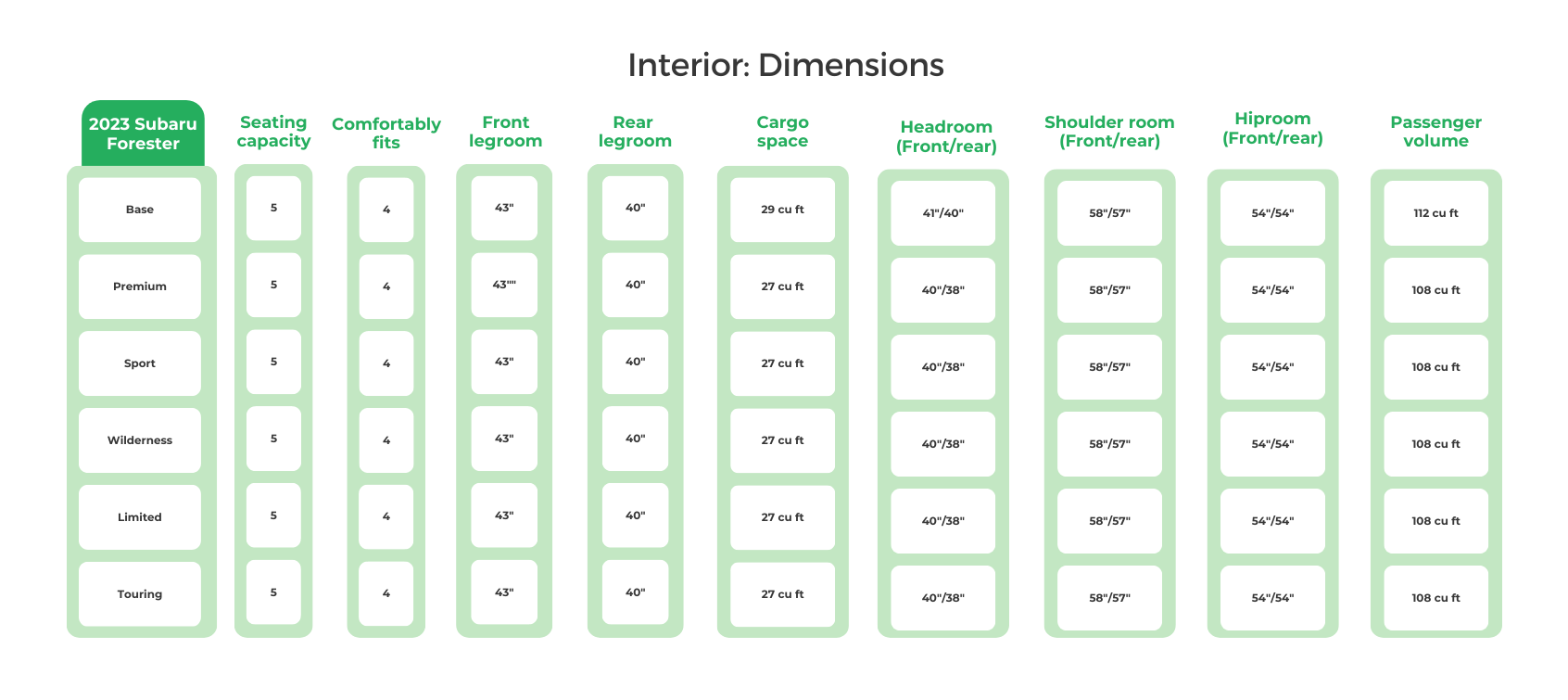
Exterior:
Exterior Features:
Wheels may also be an afterthought for many car buyers. But wheel size can impact ride quality. Larger rims can translate into better traction and cornering but may result in a bumpier ride. Bigger wheels also offer better aesthetics by filling out the wheel wells more completely. This is why the higher the trim, the larger the wheel. Different materials (steel or alloy) and finishes also help separate the wheels among the various trim levels.
If your color preferences lead towards monotone shades like white, black, silver, or gray, then you’re in luck; the RAV4 and Forester are available in these finishes. For more exciting colors, choose from available reds and blues. Get a vinyl wrap, or look for a different car if your heart is set on a more exciting finish.
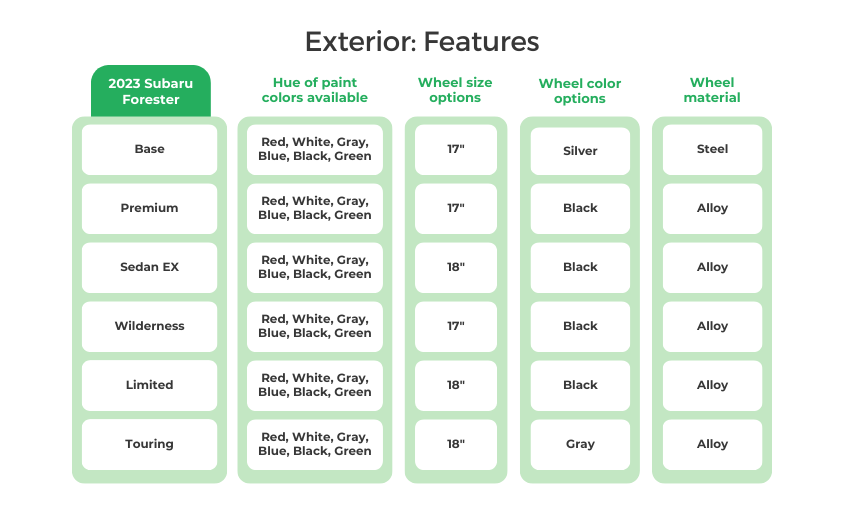
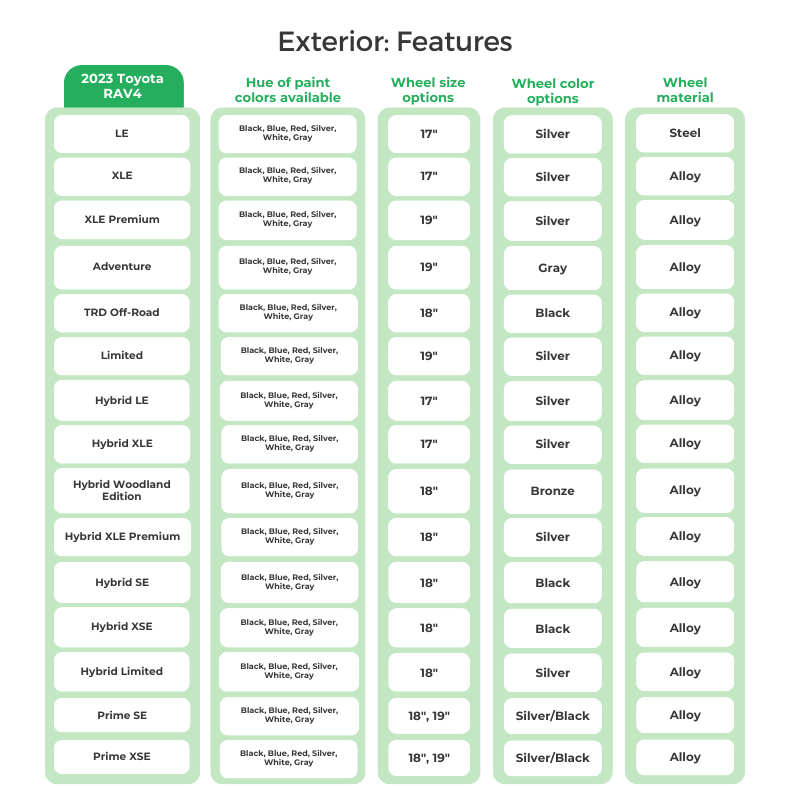
Exterior Dimensions:
Although the Forester has a bigger exterior, its 105-inch wheelbase is an inch shorter than the RAV4. Wheelbase length can affect ride comfort (longer is better). So, be sure you’re observant of this during any test drives. In addition, the Forester’s modestly larger exterior dimensions may make this Subaru more challenging to park in tight spaces.
The Subaru also gets the nod for taller ground clearance (most trims are 8.7 inches, 9.2 inches for the off-road-oriented Woodlands version). Ground clearance for the RAV4 ranges from 8.1 to 8.6 inches.
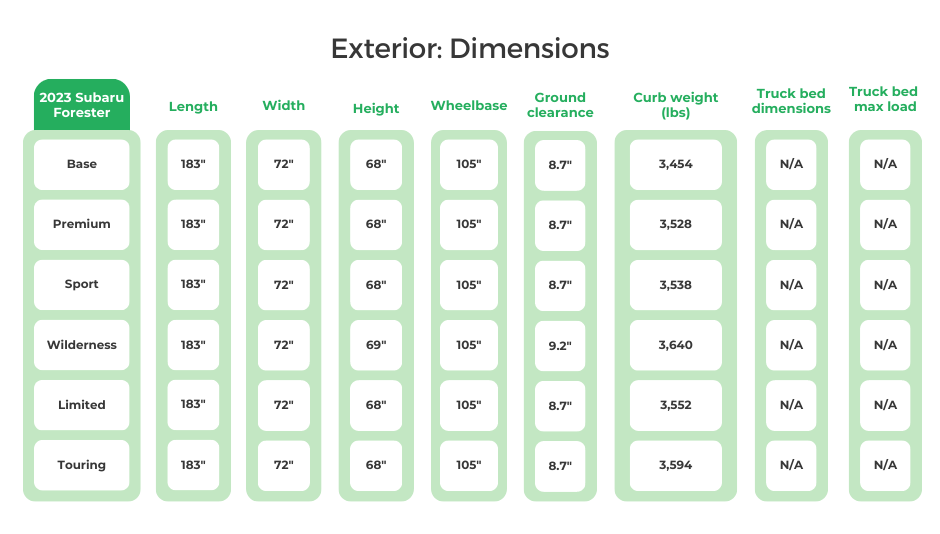

Warranty:
The Toyota RAV4 and Subaru Forester have similar manufacturer’s warranty coverage: three years or 36,000 miles of bumper-to-bumper protection and five years or 60,000 miles of powertrain safeguards (for the engine, transmission, and drive axles).
The main difference is that Subaru provides three years or 36,000 miles or roadside assistance, compared to two years or 25,000 miles from Toyota.
| 2023 Subaru Forester Factory Warranty Coverage: |
2023 Toyota RAV4 Factory Warranty Coverage: |
|
| Basic warranty: | 36 months/36,000 miles | 36 Months/36,000 Miles |
| Powertrain warranty: | 60 months/60,000 miles | 60 Months/60,000 Miles |
| Corrosion perforation warranty: | 5 years/ unlimited mileage | 60 Months |
| Air conditioning warranty: | Covered by “Added Security” extended warranty program. Varies by plan | 12 Months/12,000 Miles |
| Battery warranty: | NA | 120 months/150,000 miles (Hybrid Battery). Reduction in traction battery capacity for Plug-in Hybrid trims is not covered. |
| Emissions warranty: | Federal: 36 month/36,000 milesCalifornia: 36 months/50,000 miles (performance) | Federal: 36 month/36,000 miles (defect), 24 months/24,000 miles (performance)California: 36 months/50,000 miles (performance) |
| Roadside assistance coverage: | 36 months/36,000 miles | 24 months/25,000 miles |
| Total unique recalls: | 0 | 1 (recall no. 23V485000) |
Driver Experience | A Summary of The Top 10 Toyota RAV4 vs. Subaru Forester Reddit Posts:
Reddit has no shortage of comments about the Toyota RAV4 and Subaru Forester. We’ve summarized recent Reddit feedback (Reddit: r/whatcarshouldIbuy) about these cars.
Notably, there is an overall preference among Redditors for the Subaru Forester. Multiple commenters cite the Forester’s superior visibility, spacious interior cabin, customizable order options, handling, and acceleration as better than the RAV4.
In particular, the Forester’s all-wheel-drive system receives praise as being more capable than the RAV4’s arrangement, especially for driving on unpaved roads or during inclement weather. The Forester’s driving dynamics also invite positive feedback, with the handling and acceleration noted as feeling more responsive and agile compared to the RAV4.
While the Forester’s continuously variable transmission raises some concerns over long-term reliability, the consensus seems to be that the overall drivability and comfort of the Forester outweigh this potential drawback. Commenters also felt that ordering a Subaru was more flexible and convenient than what Toyota offers for the RAV4.
On the other hand, the RAV4 garners praise for its reputation for reliability and durability as a Toyota product. The interior design and quality materials are noted as nice features. Long-term resale value is another advantage of the RAV4. However, many feel that the RAV4 falls short of the Forester when it comes to visibility, cargo utility, drivability, and value.
In particular, the RAV4 was criticized for significant blind spots, less functional cargo area, lackluster handling and acceleration, excessive highway noise, and uncertainty around dealer availability. While the RAV4 offers a nice dashboard layout and media console, the overall feedback indicates that the Forester is the better, more well-rounded compact crossover.
Overall, the Subaru Forester appears to be the preferred choice in this segment based on reviews citing better drivability, utility, value, and customization options compared to the Toyota RAV4. While the RAV4 garners praise for reliability and interior quality, most feedback points to the Forester as the one to buy.
Who Should Buy These Cars: The Legacy of The Toyota RAV4 and Subaru Forester
As covered earlier, most RAV4 and Forester owners use their cars for transporting family and for “lots of driving” (traveling and commuting). These vehicles also can rack up miles, as survey data shows many of these Toyotas and Subarus reached 150,000 to 200,000 miles. This longevity is undoubtedly a reason these people were attracted to these cars in the first place.
The RAV4 and Forester have other appealing features: very good safety scores and good gas mileage (exceptional fuel economy with the RAV4 Hybrid and RAV4 Prime). The characteristics dovetail perfectly with these cars’ core mission of family hauling and a lot of time on the road.
The details on RAV4 and Forester safety scores and MPG are just ahead.
| Frequent Use Categories: | Subaru Forester | How Useful? (Out of 5 Stars) | Toyota RAV4 | How Useful? (Out of 5 Stars) |
| Family Vehicle | ***** | ***** |
| Lots of Driving (travel/long commute) | **** | **** |
| Hauling/Towing | * | * |
| Office on Wheels | * | * |
| Sport/Fast Driving | * | * |
| Luxurious Driving | * | * |
| Outdoor/Off-Road | * | * |
Best & Worst Years | Toyota RAV4 vs. Subaru Forester | 2001-2024

While the RAV4 and Forester enjoy good overall reputations, specific model years are best avoided. Unsurprisingly, most issues involve older examples (2008 and earlier). However, research shows that the 2002 RAV4 and 2002 and 2004 Forester escaped many problems plaguing the earliest model years. You can cherry-pick from these “best years” if the budget is tight.
Besides a few “worst years” exceptions (red), the RAV4 and Forester enjoyed a good run from 2009 to 2021. This wide range ensures there are options for most wallets. Savvy buyers often look for off-lease three to four years old vehicles. These will have some depreciation but will have the latest features.
We’ll call attention to the undecided years (yellow) only because there isn’t enough information to give these editions a thumbs up or a thumbs down.
Important Features Timeline | Toyota RAV4 vs. Subaru Forester
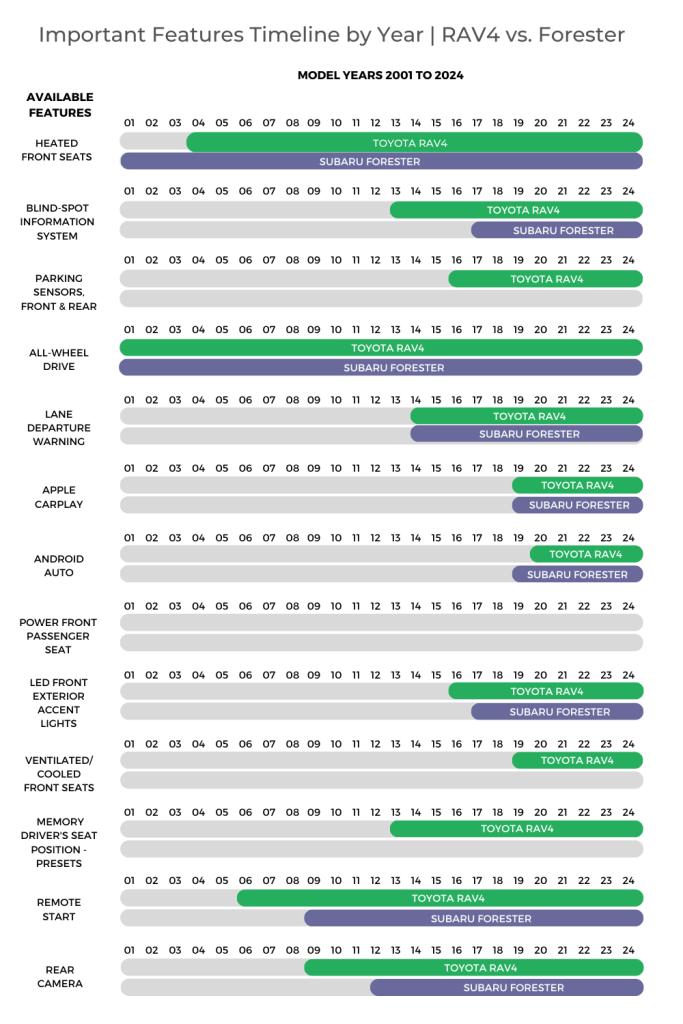
When it comes to new features in the RAV4 and Forester, Toyota clearly maintains a lead. Although this chart doesn’t represent a complete list of upgrades and launch dates, the RAV4 usually gets the goodies first. Whether this is due to Subaru’s slowness or Toyota’s more significant resources is hard to say.
Given the Forester’s popularity in northern states, it won’t surprise anyone that Subaru introduced heated front seats before Toyota. The Forester also received Apple CarPlay before the RAV4 (both cars got Android Auto in 2019).
And there are some areas that the Forester has yet to catch up with the RAV4: ventilated front seats, driver memory settings, and parking sensors. Perhaps the next-generation Forester will offer these features.
Maintenance Costs (Year-by-Year Average) | Toyota RAV4 vs. Subaru Forester
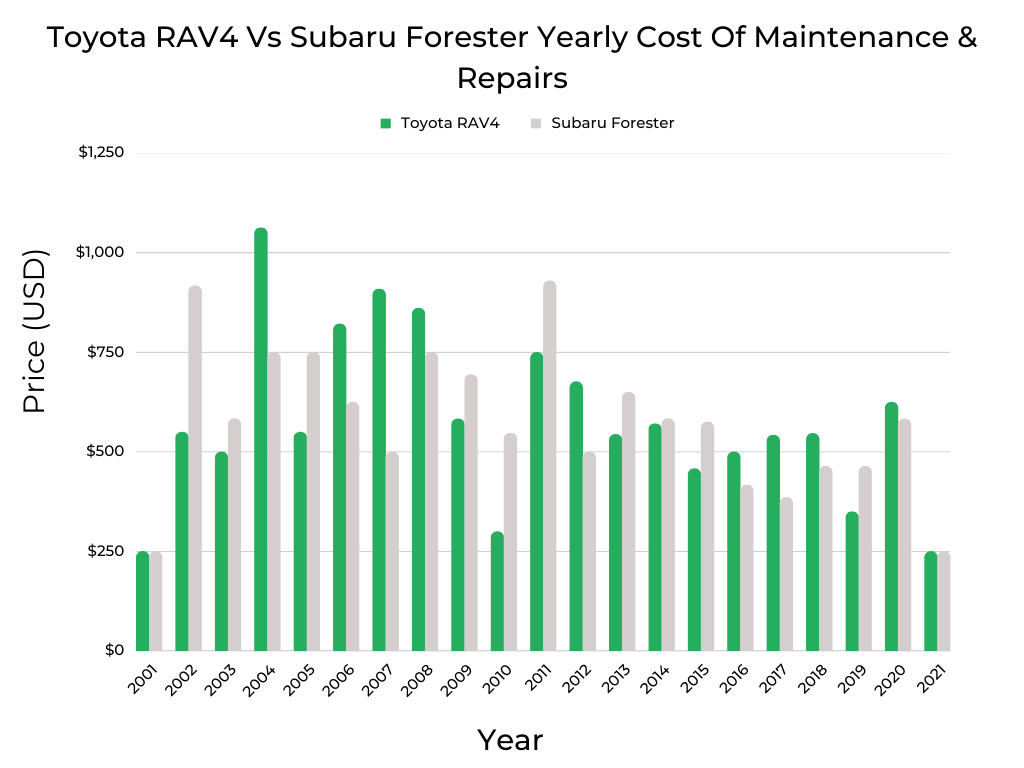
Looking at what RAV4 and Forester owners spent on maintenance in 2022, we concluded that specific models are more expensive to keep on the road than others.
After averaging all the years, upkeep costs $588 for the RAV4 and $659 for the Forester.
In simple terms, you’ll spend more owning a Forester than a RAV4 (we discussed this earlier when discussing the sweet spot model years). However, there are several RAV4 model years (2004, 2006-2008, and 2011-2012) where maintenance and repair far exceeded the averages.
Needless to say, specific Forester years (2002, 2004-2005, 2008, and 2011) have their share of high costs.
Yet, it’s vital to note that upkeep costs can vary greatly, even among different examples from the same model and year. Car ownership is unique. Some owners pamper their cars with frequent maintenance and minimal on-the-road time, while others stretch usability to the max with little upkeep and lots of driving. This is another way of saying that no two vehicles are the same, an essential consideration for used car shoppers.
Review the best and worst years of the Toyota RAV4 and Subaru Forester to learn more about maintenance and repair costs for these vehicles.
Safety Rating Comparison | Toyota RAV4 vs. Subaru Forester
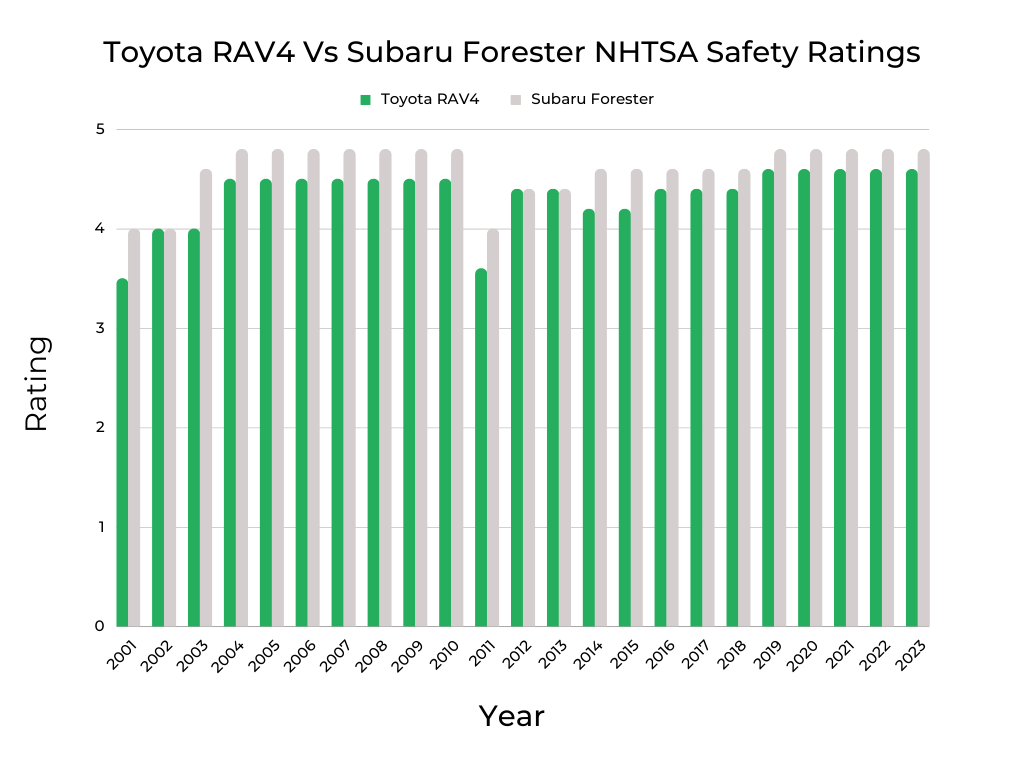
While a 5 out of 5 in NHTSA safety testing is always the goal, a score of 4 or above still provides confidence. That’s what we have with most years of the RAV4 and Forester. However, a close look reveals that the Forester edges out the RAV4 for all but three of the 23 years analyzed.
This isn’t to say that the RAV4 is bad in the safety department, far from it. But, instead, the Forester is modestly better in government tests. These results are very much in keeping with Subaru’s marketing approach that highlights the safety of its vehicles.
It’s worth mentioning that test results for both cars dropped for 2011. This is when NHTSA instituted more stringent testing. Both manufacturers took this to heart with engineering that enabled the 2012 model years to rank high once again.
More details about crash test safety scores are covered in articles about the Toyota RAV4 and Subaru Forester.
Fuel Efficiency Comparison | Toyota RAV4 vs. Subaru Forester
The early years of the RAV4 versus Forester slugfest are marked by the Subaru’s slightly better fuel economy. However, by 2014, the RAV4 caught up and sometimes topped the Forester. Yet, the differences are negligible (perhaps a 1-2 MPG advantage for some years). So, buyers looking for an edge should look at different categories (like depreciation, safety, or maintenance costs).
If fuel economy is a genuine concern, adding a RAV4 Hybrid to your shopping list will make a difference (but you’ll pay a premium above the standard gas-powered version). Debuting for the 2016 model year, the RAV4 Hybrid served as another showcase for Toyota’s leadership in electrifying conventional powertrains.
While the regular RAV4 offered about 25 MPG, the RAV4 Hybrid delivered 32 MPG or better, a 30% improvement. Newer technologies have more recent examples providing fuel economy in the 40 MPG range—a 33% increase over the conventional RAV4.
Someone driving a regular RAV4 that averages 30 MPG will spend $1,750 a year on gas (based on 15,000 miles per year and fuel at $3.50 per gallon). With a RAV4 Hybrid, costs drop more than $400 per year.
Methodology
- Compare two vehicles, Toyota RAV4 and Subaru Forester, and provide a comprehensive analysis.
- Gather relevant information and data on both vehicles from reliable sources, such as manufacturer specifications, expert reviews, customer feedback, industry reports, and data sources like manufacturer websites, FIXD App, Kelley Blue Book, FuelEconomy.gov, and NHTSA.
- Collect data on various aspects, including performance, safety features, fuel efficiency, maintenance costs, reliability, owner satisfaction, and market value.
- Identify the key criteria that will be used to evaluate and compare the two vehicles.
- Ensure the criteria cover both objective factors (such as performance metrics, safety ratings, and fuel efficiency) and subjective factors (such as owner satisfaction, comfort, and features).
- Assess the performance of both vehicles based on factors such as acceleration, handling, braking, and overall driving experience.
- Compare engine options, horsepower, torque, transmission options, and any unique performance features.
- Examine the safety features and ratings of both vehicles.
- Evaluate crash test ratings, advanced driver assistance systems (ADAS), active and passive safety features, and any notable recalls or known issues related to safety.
- Consider both NHTSA safety ratings and IIHS awards for a comprehensive safety assessment.
- Analyze the fuel economy of both vehicles based on EPA mileage estimates.
- Compare their MPG ratings, average full-tank range, and any significant differences in fuel efficiency.
- Assess the average annual maintenance and repair costs for both vehicles.
- Consider data from surveyed owners and other reliable sources, such as FIXD App owner surveys, to determine the overall cost of ownership over time.
- Evaluate the reliability of both vehicles based on owner reports, FIXD App data, and any known issues or recalls.
- Consider factors such as engine reliability, common problems by model year, long-term durability, and owner reliability scores gathered from surveys.
- Consider owner satisfaction by gathering information from forums, online communities (Reddit: r/whatcarshouldIbuy), customer reviews, and owner reliability scores.
- Summarize key factors that owners appreciate and any common complaints or drawbacks mentioned by owners.
- Compare the features and technologies offered by both vehicles.
- Highlight any notable differences in terms of infotainment systems, connectivity options, driver assistance features, interior quality, and available upgrades.
- Assess the market value and depreciation of both vehicles.
- Compare average prices, resale value, and how the vehicles hold their value over time.
- Consider average private-seller valuations from Kelley Blue Book (KBB) for a comprehensive assessment.
- Summarize the findings of the comparison, highlighting the positives and negatives of each vehicle.
- Provide a fair and balanced recommendation based on the comparison, considering factors such as budget, personal preferences, specific needs of the buyer, and the comprehensive analysis conducted.
Sources:
- KBB Values: Average private-seller valuations as supplied by Kelley Blue Book (KBB), based on a Chevrolet Equinox with typical mileage for that respective model year.
- Fuel Economy: Mileage-per-gallon estimates according to the EPA MPG on Fueleconomy.gov.
- Annual Maintenance/Repairs: Upkeep expenses as reported by surveyed Chevrolet Equinox owners.
- Safety Ratings: Crash test data collected and reported by NHTSA. We average all ratings for each year to come up with a simplified, average safety score. This makes it easier to look at on a graph. We also collected IIHS Awards for this article.
- Vehicle Features: Most or all information gathered on vehicle features were from the manufacturer websites, in this case, Hondacars.com and Toyota.com.

Dave Goldberg is an automotive journalist and lifelong car fanatic. He writes for numerous enthusiast and business outlets and is an ongoing contributor to HotCars.com, one of the most popular car culture websites. When he’s not writing or driving, Dave is either under a hood or asleep. His credentials include a BA in Journalism from The George Washington University.

